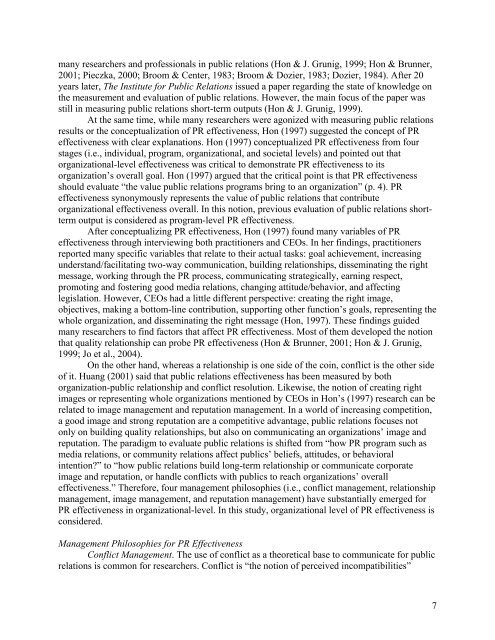2008 PROCEEDINGS - Public Relations Society of America
2008 PROCEEDINGS - Public Relations Society of America
2008 PROCEEDINGS - Public Relations Society of America
Create successful ePaper yourself
Turn your PDF publications into a flip-book with our unique Google optimized e-Paper software.
many researchers and pr<strong>of</strong>essionals in public relations (Hon & J. Grunig, 1999; Hon & Brunner,<br />
2001; Pieczka, 2000; Broom & Center, 1983; Broom & Dozier, 1983; Dozier, 1984). After 20<br />
years later, The Institute for <strong>Public</strong> <strong>Relations</strong> issued a paper regarding the state <strong>of</strong> knowledge on<br />
the measurement and evaluation <strong>of</strong> public relations. However, the main focus <strong>of</strong> the paper was<br />
still in measuring public relations short-term outputs (Hon & J. Grunig, 1999).<br />
At the same time, while many researchers were agonized with measuring public relations<br />
results or the conceptualization <strong>of</strong> PR effectiveness, Hon (1997) suggested the concept <strong>of</strong> PR<br />
effectiveness with clear explanations. Hon (1997) conceptualized PR effectiveness from four<br />
stages (i.e., individual, program, organizational, and societal levels) and pointed out that<br />
organizational-level effectiveness was critical to demonstrate PR effectiveness to its<br />
organization’s overall goal. Hon (1997) argued that the critical point is that PR effectiveness<br />
should evaluate “the value public relations programs bring to an organization” (p. 4). PR<br />
effectiveness synonymously represents the value <strong>of</strong> public relations that contribute<br />
organizational effectiveness overall. In this notion, previous evaluation <strong>of</strong> public relations shortterm<br />
output is considered as program-level PR effectiveness.<br />
After conceptualizing PR effectiveness, Hon (1997) found many variables <strong>of</strong> PR<br />
effectiveness through interviewing both practitioners and CEOs. In her findings, practitioners<br />
reported many specific variables that relate to their actual tasks: goal achievement, increasing<br />
understand/facilitating two-way communication, building relationships, disseminating the right<br />
message, working through the PR process, communicating strategically, earning respect,<br />
promoting and fostering good media relations, changing attitude/behavior, and affecting<br />
legislation. However, CEOs had a little different perspective: creating the right image,<br />
objectives, making a bottom-line contribution, supporting other function’s goals, representing the<br />
whole organization, and disseminating the right message (Hon, 1997). These findings guided<br />
many researchers to find factors that affect PR effectiveness. Most <strong>of</strong> them developed the notion<br />
that quality relationship can probe PR effectiveness (Hon & Brunner, 2001; Hon & J. Grunig,<br />
1999; Jo et al., 2004).<br />
On the other hand, whereas a relationship is one side <strong>of</strong> the coin, conflict is the other side<br />
<strong>of</strong> it. Huang (2001) said that public relations effectiveness has been measured by both<br />
organization-public relationship and conflict resolution. Likewise, the notion <strong>of</strong> creating right<br />
images or representing whole organizations mentioned by CEOs in Hon’s (1997) research can be<br />
related to image management and reputation management. In a world <strong>of</strong> increasing competition,<br />
a good image and strong reputation are a competitive advantage, public relations focuses not<br />
only on building quality relationships, but also on communicating an organizations’ image and<br />
reputation. The paradigm to evaluate public relations is shifted from “how PR program such as<br />
media relations, or community relations affect publics’ beliefs, attitudes, or behavioral<br />
intention?” to “how public relations build long-term relationship or communicate corporate<br />
image and reputation, or handle conflicts with publics to reach organizations’ overall<br />
effectiveness.” Therefore, four management philosophies (i.e., conflict management, relationship<br />
management, image management, and reputation management) have substantially emerged for<br />
PR effectiveness in organizational-level. In this study, organizational level <strong>of</strong> PR effectiveness is<br />
considered.<br />
Management Philosophies for PR Effectiveness<br />
Conflict Management. The use <strong>of</strong> conflict as a theoretical base to communicate for public<br />
relations is common for researchers. Conflict is “the notion <strong>of</strong> perceived incompatibilities”<br />
7
















